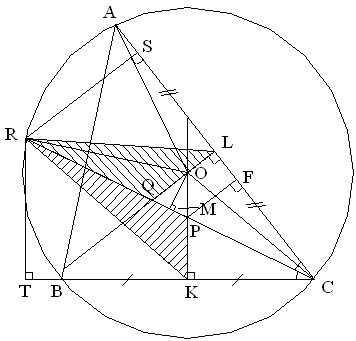Triangles with Equal Area VII
Here is Problem 4 from the IMO 2007:
| In triangle ABC the bisector of angle BCA intersects the circumcircle again at R, the perpendicular bisector of BC at P, and the perpendicular bisector of AC at Q. The midpoint of BC is K and the midpoint of AC is L. Prove that the triangles RPK and RQL have the same area. |
The solution below is by Vo Duc Dien.

|
From R draw two lines perpendicular to BC and AC meeting them at T and S, respectively. Also, let the perpendicular from P to AC meet AC at F.
To prove that the two triangles RPK and RQL have the same area suffice it to show that
| (1) | TK×PK = SL×QL. |
Since CR is the bisector of ∠ACB, ΔKPC = ΔFPC and, similarly,
| (2) | PF / QL = SL / SF. |
But SL / SF = RQ / RP (since the three lines RS, QL, and PF are parallel), so that (2) is equivalent to
| (3) | QL / PF = RP / RQ |
Also note that QL / PF = QC / PC, implying that (3) is equivalent to
| (4) | QC / PC = RP / RQ. |
Now, QC = QP + PC and RP = RQ + QP which reduces (4) to
| (5) | PC = RQ. |
Thus (5) is equivalent to (1) such that proving (5) solves the problem.
Note that O is the circumcenter of ΔABC. Let M be the foot of the perpendicular from O to RC.
Angles MOP and PCK that have perpendicular sides are equal, and for the same reason
| (6) | OQ = OP. |
Note that
| (7) | OR = OC |
(since R is on the circumcircle of ΔABC with the circumcenter O). This makes ΔCOR isosceles. In particular, ∠ROM = ∠COM and then also
| (8) | ∠ROQ = ∠COP. |
From (6)-(8), ΔROQ = ΔCOP and, finally,
2007 IMO, Problem 4
|Activities| |Contact| |Front page| |Contents| |Geometry|
Copyright © 1996-2018 Alexander Bogomolny73589507
